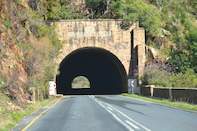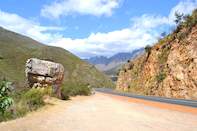Mountain Road
Du Toitskloof Pass is a well-constructed mountain road that leads from Paarl to Worcester in the Western Cape. Nowadays the Du Toitskloof Pass has become a secondary road to the Huguenot Tunnel on the N1 highway, which easily transports capetonians to the Cape Winelands.

If you are looking for a more scenic drive steeped in rich history, cross the Du Toitskloof Pass for a memorable route.
The Du Toitskloof Pass has an interesting history dating back to the 18th century. When the Huguenot settlers arrived in the Cape, Francois Du Toit came along, acquiring a piece of land for farming which he Kleine Bosch, just below the Hawequa Mountains.
Du Toit was the first person to pass the ‘neck’ above his farm, overlooking the valley that would one day bear his name. After agricultural activity expanded in the region, livestock started grazing in the Du Toitskloof valley, just beyond the top of the future road. Gradually a cattle track formed on the mountains, which was not really accessible to man as it was a steep and tricky road.
In 1778, the governor of the Cape mentioned the possibility of a wagon road, but nothing came of it. The cattle track stretched further past various farms, zigzagging up slopes and straightening into the kloof.
Early Construction

40 years later, an enterprising German man named Detlef Siegfried Schonfeldt bought Du Toit’s farm, and came up with the idea to fund a road for farmers through the kloof. After much debate, the surrounding farming community agreed and funds were raised. The government then became involved, supplying the necessary tools and explosives for the task.
Schonfeldt started the construction of a wagon road over the most tricky part of the kloof, and soon depleting the farming community’s funds. He then approached the government and offered to trade them the kloof in exchange for the necessary funds to complete the road. After the government turned down the proposal, it was brought up again in 1858 by a civil engineer, but due to a lack of funds it could not be built.
In the 1890’s, a manganese mine was opened just above Du Toitskloof, and transporting the ore became a concern. Various solutions were brought to the table, but none materialised and the mine eventually closed down.
The next person to tackle the road was Jannie le Roux, who started farming in the area around 1934 and built a private road for easier access his farm’s camps. In the 1940’s, another survey was conducted to assess the viability of a road and it was finally decided that one was needed.
After the outbreak of the Second World War, South African became host to a large number of Italian Prisoners of War. The government made a deal with the skilled labour, offering food in exchange for their work. The Italians agreed and construction on Du Toitskloof Pass began. After the war ended, local labour was used and the pass was completed in 1949.
 Du Toitskloof is situated within the Cape Winelands in the Western Cape Province. The Du Toitskloof mountain range forms a formidable barrie...
Du Toitskloof is situated within the Cape Winelands in the Western Cape Province. The Du Toitskloof mountain range forms a formidable barrie... The impressive Du Toitskloof Pass lies between Paarl and Worcester as it snakes up and over the majestic Du Toitskloof Mountains. The surrou...
The impressive Du Toitskloof Pass lies between Paarl and Worcester as it snakes up and over the majestic Du Toitskloof Mountains. The surrou...